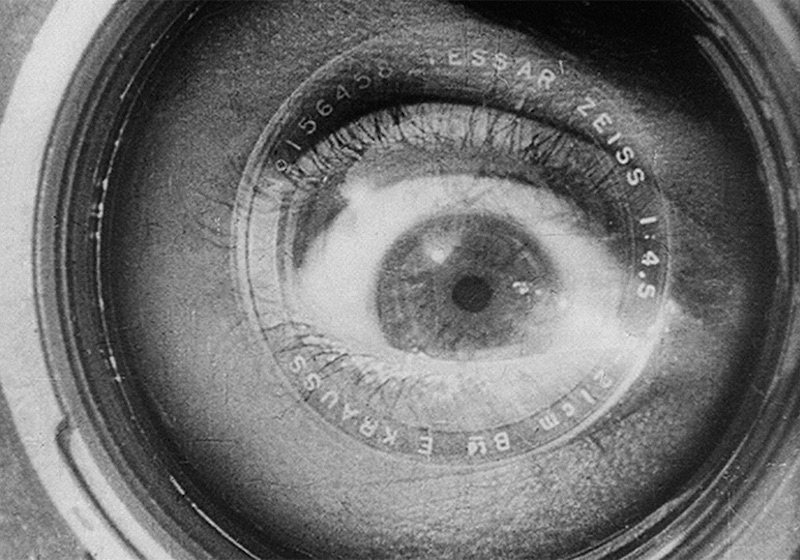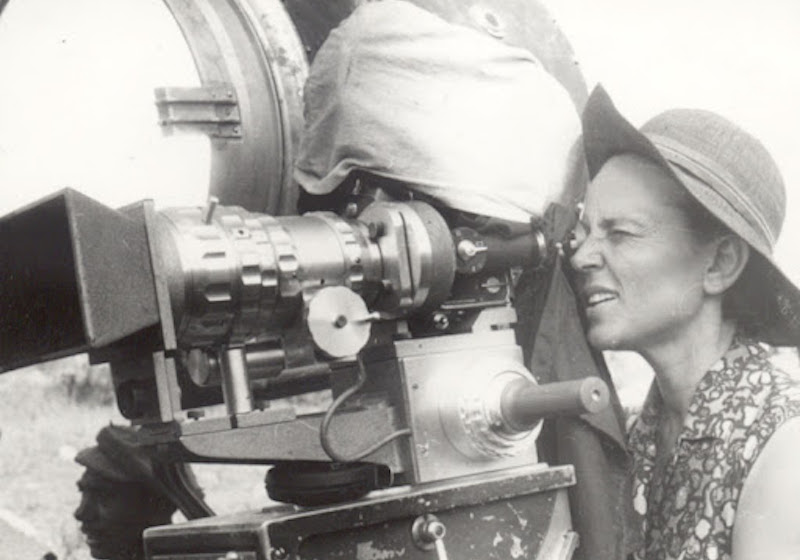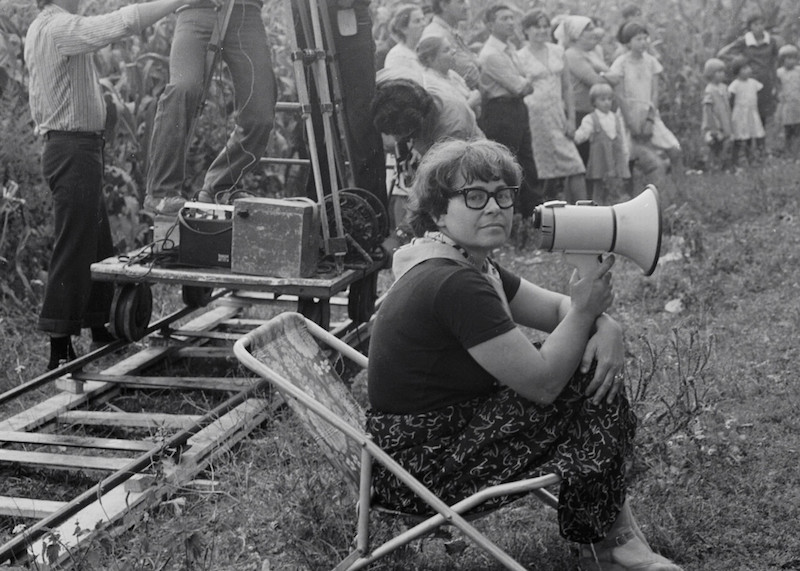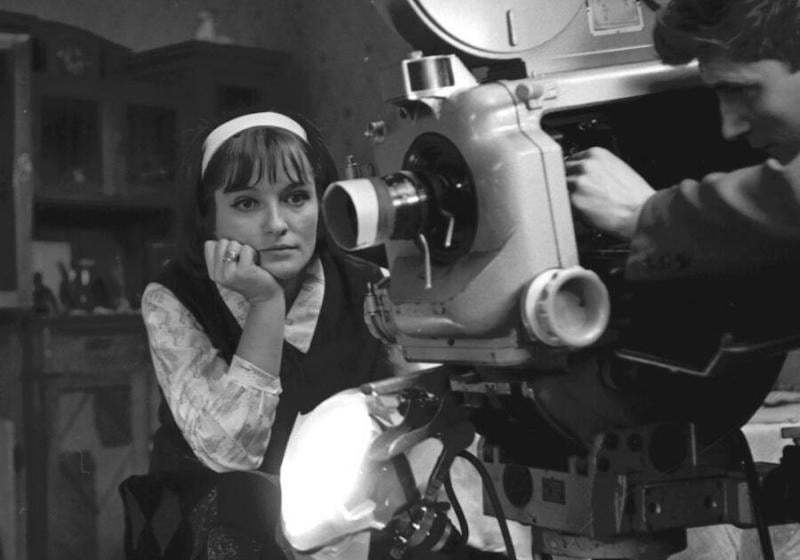Elizaveta Svilova: the woman behind The Man With a Movie Camera

Editor Elizaveta Svilova is best known for her partnership with her husband Dziga Vertov, playing a crucial role in the making of his seminal documentary Man with a Movie Camera. However, Svilova also made more than a hundred films away from Vertov, including several important works documenting the fallout of the Second World War. These powerful pieces of reportage position Svilova as a filmmaker right at the centre of a turbulent and fascinating historical moment. Yet despite her extensive career and fascinating story, Svilova’s contribution remains absent from most histories of Soviet film.
Beginnings
Elizaveta Svilova was born in Moscow on 5 September, 1900, the daughter of a railway worker and a housewife. Svilova’s father was killed in the civil war, and her working-class background cut her schooling short. At the age of 12, she instead began work as an apprentice in a film laboratory before becoming an assistant editor at Pathe. By 1922, she was working at state-run production company Goskino, drawing upon her already extensive experience to run workshops for her peers.
Early Soviet cinema included a significant number of women in a variety of roles: producing, directing, screenwriting, and editing. Svilova’s Goskino workshops would have been full of other women, female lab workers and editors. In later years, the formalisation of the film industry would force many of these women out of their roles, although a strong female presence was still felt in editing rooms across the country. Editing, with its meticulous slicing and splicing, was seen as akin to handicrafts such as sewing, and as such highly suitable for female hands. But aside from Svilova and her contemporary Esfir Shub, little is known about these female “cutters.” As the Women Film Pioneers Project proves, although we can find some names — Klaudia Ivanovna Kulagina, Katerina Nikolaevna Kozina, Vera Kimitrovna Plotnikova — it’s impossible to know how many women contributed uncredited to films of this era.
Svilova’s numerous female peers reflect the development of cinema up to this point. As a new medium, synonymous with modernity, it was not yet subject to the same gatekeeping as other artforms. It also reflects the optimism of the historical moment. Equal rights for women had been enshrined in the 1918 Soviet Constitution, and while the Bolsheviks’ theoretical commitment was not fully supported by policy or practice, the young women who found work in film at this time were emblematic of a new, emancipated Soviet woman.
As directors came to be seen as the key creative force in filmmaking, the role of the editor would be increasingly perceived as a technical, rather than a creative, art. But as Svilova proved throughout her life, the role of the editor is vital in film. In a true partnership, an editor can be as visionary as a director — and nowhere is that clearer than in Svilova’s work with Dziga Vertov.
Work
Even before she married Vertov in 1923, Svilova was already assisting her future husband on his films. In 1922, the couple formed the Kinoki collective alongside Vertov’s brother, cinematographer Mikhail Kaufman. Their goal was to create films that would capture truth, and their attitude was exuberant and anarchic as their manifesto demonstrates:
WE proclaim the old films, based on the romance, theatrical films and the like, to be leprous.
—Keep away from them!
—Keep your eyes off them!
—They’re mortally dangerous!
—Contagious!
Throughout the 1920s, Kinoki advocated for a new kind of film that would avoid sets, props, and actors, instead documenting the lives of real people. Their Kino-Pravda, or “cinema truth” newsreels exemplified this idea by trying to create a kind of “screen newspaper”.
The Kinoki also pioneered an experimental form of montage. They took this essential tenet of Soviet filmmaking — the idea that unrelated images shown sequentially can convey an idea or feeling to the viewer — and pushed it to extremes. These experimentations reinforced the collective’s assertion that the camera could capture a deeper truth than the human eye. Svilova’s skill as an editor was crucial, and her expertise allowed the team to use techniques like superimposition, repetition, and jump cuts to dazzling effect. Vertov would later describe his wife as “the best editor in the USSR”.
One Key Scene
These experimental montages are at the heart of Man with a Movie Camera (1929), the film for which Svilova is best known. The city-symphony is a frenetic portrait of a busy 24 hours in an unnamed Ukrainian city (in fact, the movie shows three cities, all cut together – Odesa, Kharkiv, and Kyiv) as seen through the lens of the titular cameraman, who appears on screen filming the action. Shots of people, streets, and buildings recur in dizzying sequence. There is no plot, but the viewer finds meaning in the film’s playful, sometimes poignant, juxtapositions. At City Hall, footage of a couple signing their marriage license is placed alongside others filing divorce papers; elsewhere, a birth is intercut with a funeral. All the while, the city churns in constant motion.
A third of the way through the film, however, we suddenly stop. A galloping horse pauses mid-stride; a carriage freezes in a blur of motion; a busy street turns to stone. Stills of images we have seen already reappear as negatives on a roll of film held in a woman’s hand. We have entered the editing room and here, sat amongst the reels, is Svilova herself. For the rest of the film, Svilova reappears as a recurrent character, snipping and splicing as she constructs the very film that we are watching.
At the centre of film sits Svilova at her editing bench, a woman without a movie camera, but a filmmaker nonetheless.
These editing sequences are a meta-joke in keeping with a film that is constantly asking its audience to consider how the images they see have been constructed. Man with a Movie Camera is a film about modernity, a celebration of new kinds of image-making made possible by the mechanical eye of the camera. Yet, by including Svilova as a character, the film also positions the invisible human art of editing as an essential part of filmmaking, the feminised counterpoint to the masculine cameraman. At the centre of film sits Svilova at her editing bench, a woman without a movie camera, but a filmmaker nonetheless.
Influence and Legacy
Vertov’s career peaked with Man with a Movie Camera, but Svilova’s did not. During the 1930s, avant-garde filmmaking fell out of favour, only to be replaced by state-approved socialist realism. Vertov refused to adapt his work to follow the party line. For a while, the couple were able to work together, with Svilova increasingly credited as a co-director on her husband’s films. But eventually, Vertov was blacklisted by the party. With her husband unable to work and afflicted by ill health, Svilova turned to solo commissions with considerable success. Between 1939 and 1956 she directed and/or edited more than 100 documentaries and newsreels.
These films positioned Svilova as a documentarian at the vanguard of history. She played an active role in depicting the fallout of the Second World War, on films including Fall of Berlin (1945), Auschwitz (1946) and Fascist Atrocities (1946). Her concentration camp films have been criticised for failing to acknowledge the specificity of Jewish suffering, and it is true that the films downplay ethnicity to present the Holocaust as an atrocity against the Slavic people — a line enforced by the Soviet authorities. Nonetheless, these films preserve a vivid account of genocide, and Atrocities was even submitted as evidence in the Nuremberg trials. Judgement of the Nations (1946, co-directed with Roman Karmen) is itself an account of those trials.
Despite her impressive output, Svilova will always be best known for her work alongside her husband. This is partly to do with availability — Svilova’s later work is not easily accessible, whereas Man with a Movie Camera can be viewed online for free — but it’s also a consequence of Svilova’s decision to promote her husband’s legend at the expense of her own. When Vertov died in 1954, he was an artistic and political outcast. Svilova dedicated the rest of her life to his legacy, preserving his prints and disseminating his writings. Her efforts would pay off. By the 1960s, Man with a Movie Camera had been embraced by the European avant-garde. Its reputation has only grown over the decades. In 2014, Sight & Sound voted it the best documentary of all time.
By cementing her husband’s status as the father of Soviet documentary, Svilova has obscured her own achievements. Most studies of Vertov still underplay Svilova’s contribution, and her solo films remain underseen. As long as we fail to acknowledge the artistic contribution of the editor to cinema, our understanding of the role of women in film history will remain partial, and the man with the movie camera will continue, unfairly, to eclipse the woman at the editing bench.
This article is part of our series Women, Recollected, an ongoing project shining a light on the forgotten women pioneers of 20th century culture.


